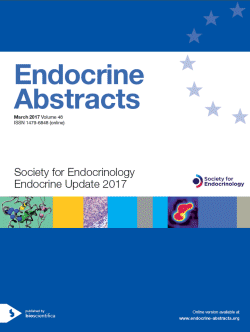Clinical Update
Workshop F: Disorders of the parathyroid glands, calcium metabolism and bone
ea0048wf1 | Workshop F: Disorders of the parathyroid glands, calcium metabolism and bone | SFEEU2017
A case of hypercalcaemia in Hyperparathyroidism-jaw tumour syndrome
ea0048wf2 | Workshop F: Disorders of the parathyroid glands, calcium metabolism and bone | SFEEU2017
Giant parathyroid cyst – a rare cause of severe hypercalcaemia
Rehman Shoib Ur , Pazderska Agnieszka , Van Tornout F. , Pain Simon , Francis Jonathan , Gunda Rohini , Ahluwalia Rupa
ea0048wf3 | Workshop F: Disorders of the parathyroid glands, calcium metabolism and bone | SFEEU2017
Hypercalcaemia with inappropriate parathyroid hormone (PTH) levels
ea0048wf4 | Workshop F: Disorders of the parathyroid glands, calcium metabolism and bone | SFEEU2017
Primary hyperparathyroidism due to parathyroid carcinoma
Thurtell Craig , Schofield Christopher
ea0048wf5 | Workshop F: Disorders of the parathyroid glands, calcium metabolism and bone | SFEEU2017
A case of non-parathyroid hormone-mediated hypercalcaemia
Mills Edouard , Naqvi Ali , Todd Jeannie
ea0048wf6 | Workshop F: Disorders of the parathyroid glands, calcium metabolism and bone | SFEEU2017
Primary hyperparathyroidism – that’s easy for you to say
ea0048wf7 | Workshop F: Disorders of the parathyroid glands, calcium metabolism and bone | SFEEU2017
Familial Hypocalciuric Hypercalacaemia
Jagannatha Hema , Allen Kate , Ward Alexandra , Chen Mimi
ea0048wf8 | Workshop F: Disorders of the parathyroid glands, calcium metabolism and bone | SFEEU2017
A case of transient hypercalcemia
ea0048wf9 | Workshop F: Disorders of the parathyroid glands, calcium metabolism and bone | SFEEU2017
Hypercalciuric hypocalcaemia – potential pitfalls and a novel treatment option
Gorrigan Rebecca , Shaho Shang , Drake William
ea0048wf10 | Workshop F: Disorders of the parathyroid glands, calcium metabolism and bone | SFEEU2017
Severe hypercalcaemia and osteoporosis in a patient with primary hyperparathyroidism
Ramli Rozana , Robinson Stephen , Yee Michael , Palazzo Fausto , Cox Jeremy PD , Comninos Alexander N




